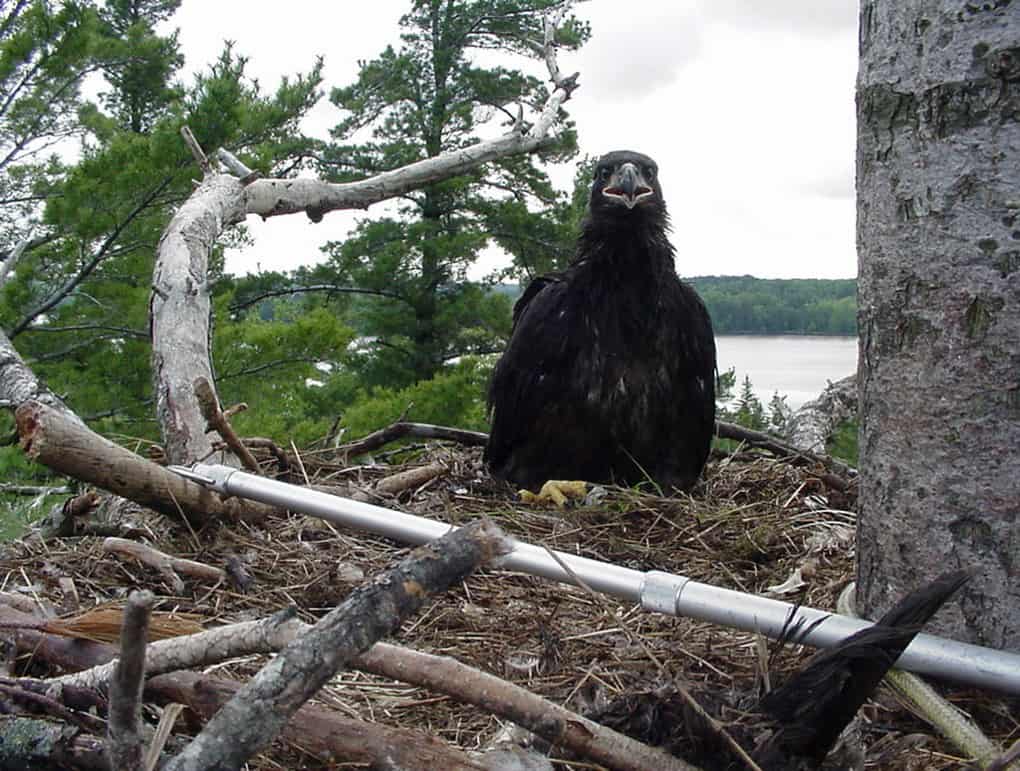Share this article
High levels of novel chemicals found in Great Lakes eagles
For bald eagles nesting close to the shores of the Great Lakes, high chemical levels — including compounds previously found in the species and new or emerging ones — may impact the species’ ongoing recovery.
Several PFAS — a group of human-made chemicals found in many household products — were found in these eagles at levels that are cause for concern, said Marta Venier, an environmental chemist at Indiana University and the senior author of a study published recently in Environmental Pollution.
Bald eagles became threatened in the 1970s due to the effects of DDT, which caused eagle shells to thin. After the pesticide was banned, the birds began to recover. But the recovery was never as complete as conservationists hoped. Researchers believed other chemicals might be affecting the raptors. They have since found that eagles indeed were contaminated by a number of PFAS, or perfluoroalkyl and polyfluoroalkyl substances, chemicals commonly used in cleaning products, stain repellants, Teflon and other household and industrial products.
“Every time we have looked for chemicals, we have found them,” Venier said.
William Bowerman, from the Department of Environmental Science and Technology at the University of Maryland, provided eggs and plasma of bald eagles (Haliaeetus leucocephalus) around the Great Lakes area to Venier and lead author Yan Wu, a postdoctoral researcher in environmental chemistry at Indiana University, who looked for the presence of a variety of older and newer chemicals.

Bald eagles closer to the shore of the Great Lakes had higher concentrations of PFAS. ©Kendall Simon
“There are a lot of pollutants in these eggs, which is not something we want to see in general,” Venier said. “Our study about PFAS confirms this idea that these birds are exposed to what I like to call a chemicals’ soup.”
Among the chemicals they found were so-called legacy PFAS, compounds that have been banned but persist in the ecosystem. “Once they are out there, they are impossible to break up,” Venier said. Many PFAS are water soluble and are ingested by bivalves, which are in consumed by other animals, eventually affecting species like bald eagles as the chemicals accumulate up the trophic pyramid.
The researchers found high levels of these legacy PFAS in birds nesting around Lakes Superior, Michigan and Huron, but they also found indications of newer and emerging PFAS currently used in a number of products. More than 5,000 of these PFAS exist. The researchers found nearly 30 of them in the eagles, and Venier said many more are likely out there.
“What we measured is probably just the tip of the iceberg and it is limited by what we can measure,” she said.
Eagles nesting closer to Great Lakes shoreline or tributaries where spawning fish were accessible had elevated levels, they found, indicating that chemical concentrations are likely higher in the Great Lakes breeding areas than they are in the inland breeding areas. The toxicity of many of these new and emerging PFAS is still poorly understood, Venier said, and while legacy PFAS have been found to cause cancer and liver problems in humans, less is known about how they affect eagles.
Research on the hatching success of eagles exposed to legacy PFAS found that eggs holding a PFOS (perfluorooctanesulfonic acid) concentration of more than 100 nanograms per gram had disrupted embryonic development, said Wu, a postdoctoral associate at Indiana University. More than half the eggs the team studied exceeded that threshold.
“Maybe the eagles in the Great Lakes region are suffering from the adverse effects of these PFAS,” he said.
While little can be done to clean up the legacy chemicals in the ecosystem, Venier said, efforts can focus on decreasing the production of new chemicals.
“As soon as one chemical is discovered to be toxic or bad, the chemical industry replaces it with something that is slightly different from a structural point of view, but probably similar in health effects,” she said. “They need to be regulated on a class basis, not on a compound basis.”
Header Image: Bald eagles closer to the shore of the Great Lakes had higher concentrations of PFAS. ©Rachel Kramer








